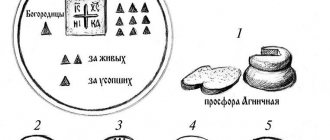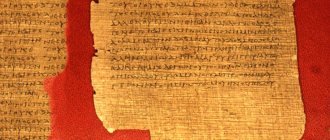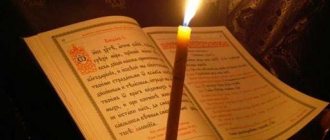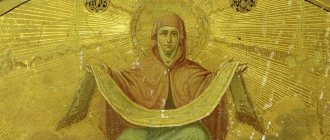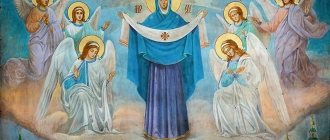What is kontakion in Orthodoxy
Kontakion (translated from Greek as “a stick on which a scroll with text was wound”) is one of the most important Orthodox prayers dedicated to a particular sacred event or holiday. The kontakion, in contrast to the troparion, illuminates in more detail the reasons for the acts and exploits of the saints, and reveals the essence of the holidays. The troparion tells about a specific action or event.
The ancient kontakion was a multi-stanza poem (from 8 to 40 stanzas - ikos). In its modern form, kontakion is small prayers. They contain not only the prayer itself, but also a brief explanation of the holiday or glorification of the saint. The authors of kontakia called them hymns, creations, and praises.
The kontakion consisted of introductory stanzas called kukulia or proimia. Further, the ikos of the kontakion are constructed according to certain rules. The same number of lines in stanzas, uniform alternation of stressed and unstressed syllables and the same number of syllables in the corresponding lines of each stanza-ikos.
Prayer book page with troparia and kontakion
When to read the Akathist
Prayer comes in different forms, first of all - church prayer, it is the most important, since all the church Sacraments are performed in the church, giving salvation to the soul. But there is also a home or cell room. At home, many believers like to read various akathists. What it is? This is a type of church poetry. If the name is translated from Greek, it indicates that you cannot sit while saying these prayers (for example, while reading kathisma, you can).
There are no church instructions on when it is necessary to turn to akathists. Every believer is free to read them according to the desire of his own soul. Usually they read one per week, or even daily - if you have enough spiritual strength. As a rule, they resort to this form of prayer when they want to pray for something serious:
- during illness;
- if you want to find a groom or conceive a child;
- when the wife wants her husband to stop drinking;
- about ending wars;
- They also ask for household needs.
Work as a courier at Yandex.Eda (up to 3,400 rubles per shift) leave a request →
What is reading akathists by agreement? It's very simple - people agree to read the same text at the same time. It so happens that, being in different places, they simultaneously offer their petitions to the Lord. The effect of such a reading will be much stronger than from a single one.
How did kontakia appear?
The history of the appearance of kontakions is connected with the Monk Roman the Sweet Singer (V-VI centuries). He was originally from Syria, but later moved to Constantinople, where he helped Patriarch Euthymius at divine services. The Patriarch brought Roman closer for his virtuous life and strong faith. But the Monk Roman was not endowed with any innate talents. Because of the patriarch's mercy towards himself, he constantly experienced the envy and discontent of the cathedral ministers. One day they decided to disgrace the Monk Roman by pushing him into the pulpit during a service and forcing him to sing. In the presence of the emperor and patriarch, the saint disgraced himself due to his indistinct singing and lack of voice.
The Monk Roman was very worried about what had happened and prayed earnestly. The Most Holy Theotokos appeared to him in a dream, handed him a scroll and ordered him to swallow it. Roman obeyed. A miracle happened: the monk acquired a beautiful, melodious voice and discovered the gift of composing poetry. In gratitude for the miracle that happened, he wrote the first kontakion for the feast of the Nativity of Christ:
“Today the virgin gives birth to the Most Essential, and the earth brings a den to the Unapproachable; Angels and shepherds praise, while wolves travel with a star; For our sake, the Child of Mlado, the Eternal God, was born.”
Rev. Roman eventually became a famous hymnographer of the Church and created many prayer and liturgical texts. For example, such as “Songs of St. Roman the Sweet Singer for Holy Week”, “Kondak on Monastic Life”.
When akathists are read in church
Many people, being in the temple for the first time, reading the church schedule, do not understand everything. For example, what is a prayer service with an akathist? They are served on special days. For example, before the New Year, the start of school. Believers can independently order prayer services - before the start of an important task, before leaving, on name day. If desired, this rite can be combined with an akathist and the blessing of water.
Only according to canonical rules, such a service is not allowed immediately after the Liturgy, because it is a shortened version of the evening service. Therefore, you should not insist on your own if the priest appoints a different time. Prayer services can be served not only in the church - you can invite the priest to your home, to an event, to the field (to bless the future harvest). Only a clergyman is allowed to serve it, but akathists are read freely by the laity.
- Water Blessing Prayer - what is it?
- Roman Sweet Singer - prayer, icon, troparion - find here
- Bell ringing to cleanse the home, soul and body -
The use of kontakia in worship
In ancient times, kontakia were poems glorifying God, the Mother of God and the saints. Later, kontakia began to be used less frequently and their place was taken by more strict, restrained canons. However, in the Russian Church, kontakia have become one of the favorite temple prayers. At the same time, the number of stanzas was significantly reduced. Kontakia are an integral part of akathists, which include 13 kontakia and 12 ikos. In akathists, kontakia are short songs of praise in honor of holidays, the Mother of God or saints.
In the Russian Orthodox Church of our day, kontakia occupy a rather modest place, although they are sung during services. The kontakion is found after the 6th song of the canon at Matins. It conveys in more detail the very essence of the holiday, in contrast to the short troparion. They can be heard at Matins, readings of the 1st, 3rd, 6th, 9th hours, pictorial, Compline, as well as at the Divine Liturgy. It should be noted that the kontakia in their modern form are practically no different in size from the troparia.
Church troparia, history of appearance and dedication
In the early Church, troparia, and these were musical comments on the ongoing divine service, were written not in poetry, but in prose in a certain rhythm. The poetic form of this type of chant appeared at the end of the fourth century.
Troparion is a song that speaks about the essence of the holiday
Over time, church hymnography was filled with several types of troparions dedicated to a specific day, holiday, or saint. The voice leads the church hymns. The words of the troparion reveal the essence of the service or glorify the name of some saint.
Kontakion is an extended troparion in which the main theme is revealed more fully. The troparion sounds in songs, and the kontakion is performed in poetic form. Hearing church hymns, one can determine by their meaning what event or saint the service is dedicated to.
Read about the services:
- Divine Liturgy
- The rite of the priest
- Features of worship for the holiday of Christmas
Roman Sladkopevets acquired the right to be considered the first author of church hymns, having gone through humiliating trials. Being a deacon of the church in Greece, deprived of hearing and voice, the pious young man was under constant ridicule of his brothers, they more than once pushed him to lead the songs, and this was a shame and new mockery.
Roman expressed his grievances in his nightly prayers to the Mother of God, and one day the Mother of God appeared to him in his cell with a scroll. She ordered the deacon to eat the scroll, after this night the young man became not only the best church singer with a unique voice, but also received the gift of writing hymns.
Advice! If you want to learn to sing, pray to Roman the Sweet Singer. He is the author of the first Christmas troparion, which is still performed today.
The Charter of the Church of Constantinople contains the first troparia written by Roman the Sweet Singer.
Venerable Roman the Sweet Singer
The troparion and kontakion are performed once on each patronal feast, only on Easter the “Christ is Risen” is repeated three times.
Examples of kontakia for saints and holidays
Kontakion to the Mother of God
To the chosen Voivode, victorious, as having been delivered from the evil ones, let us sing thanksgiving to Thy servants, the Mother of God; but as if you have an invincible power, free us from all troubles, and let us call to You: Rejoice, unmarried Bride.
Easter kontakion
Even though you descended into the grave, Immortal, you destroyed the power of hell, and you rose again as the Conqueror, Christ God, saying to the myrrh-bearing women: Rejoice, and grant peace to your Apostles, grant resurrection to the fallen.
II. Hymnography
The canon is the latest form of Byzantine songwriting, which in its present volume and forms ended in the 8th – 9th centuries. This is a complex chain of different Old Testament hymns intertwined with Christian chants. This type of hymnographic creativity was loved by Byzantine writers; The first attempts to compile canons easily found imitators, and very quickly the canons took the leading place in liturgical use, completely displacing kontakia from use. It's hard to say what the secret of such success is. It must, however, be admitted that in a large number of cases, later imitations of the first models leave much to be desired; the need to adhere to one specific form and standard often gives individual troparions and even songs of the canon the character of meaningless praise for a given person or event. With the question of the canons, a number of parallel topics arise, the resolution of which is important for the liturgist: this is the connection of the canons with biblical songs, the history of the canons, the composition of the canon; In addition, the history of the scientific development of the canons and, in connection with this, the history of Greek hymnography in general is very instructive.
Biblical songs, which were discussed briefly above, represent the rationale for the canons. It is necessary to become familiar with their content and the mutual connection between these songs and the songs of our canons. In total, 12 songs are recorded in the Bible, but the songs of Deborah (Judg. V ch.) and Hezekiah (Is. 28:11-20) were not included in our worship in any way and, thus, ten songs form the background of our canon. At the same time, some songs were combined into one, and some, on the contrary, were divided. Schematically it looks like this:
The Song of Moses (Ex. 15:1–19) gave 1 paragraph of the canon and 2 paragraphs (Deut. 32:1–43); Anna (I Kings 2:1–11) – 3 p.; Habakkuk (Habakkuk 3:1–19) – 4 p.; Isaiah (Is. 26:9–19) – 5 p.; Jonah (Jon. 2:3–10) – 6 paragraphs. The Three Youths made up two songs of the canon, namely (Dan. 3: 26–56) gave 7 paragraphs of the canon, and (Dan. 3:67–88) – 8 n. The Song of the Mother of God (Luke 1:46–55) did not create a separate song of the canon, but entered as an unchangeable part and in its entirety on almost all days of the year, as the so-called. “The most honest”, standing between 8 and 9 points of the canon. The Song of Zechariah (Luke 1:68–79) gave 9 paragraphs of the canon.
Skaballanovich notes: “The songs are arranged in approximately chronological order in the canon; only the song of Habakkuk is rearranged with the song of Jonah, perhaps in order to take a more touching biblical song for the 6th song of the canon, as the final one in the section. At the same time, one cannot help but notice that joyful songs took odd places, and mournful ones - even ones (cf. Six Psalms), excluding songs 7 and 8, where for this principle the end of the song would have to be placed before the beginning ... "
The accusatory song of Moses from Deuteronomy, which by its nature formed the theme of the second song of the canon, is confined only to the time of Great Lent, so that during most of the church year the second song is absent from the canon.
These mentioned nine biblical songs (or, more precisely, eight, since the song of the Mother of God stands completely apart) gave themes to the authors of the canons for composing individual songs of it. This is quite obvious from the content of the so-called. “irmos”, which are very often composed of individual expressions of a given biblical song, or even reproduce it entirely. As an example, one can give: “This is my helper and protector for salvation, this is my God and I will glorify Him, God of my Father and I will exalt Him, gloriously I will be glorified,” or “look up to heaven and I will say,” ... Sometimes this connection is not literal, but nevertheless, ideologically quite consistent, as for example: “Ion stretched out his hand crosswise in the womb of the water beast, representing the saving passion in reality...”, or “To the golden image on the field of Deira...”, etc. But very often no connection, either literal or in content, will be preserved in one or another irmos, as for example, in this case, as the most frequent chaos of the year: “I will open my mouth and be filled with spirit and burp the word to the Queen Mother and appear brightly triumphant and I will sing and rejoice at those miracles.” Or: “To the King of Kings, from Jacob one word has come…”
In the ideal that lies before the creator of the canon, the theme of a biblical song should be maintained not only in the irmos of a given song, but also in all its troparions, which, of course, is impossible. In addition to being faithful to the biblical content of the song, the author must also include in this song the canon and glorification of the saint of today or the event being celebrated. Sometimes this is done masterfully, especially when there is a direct connection to it; more often you have to resort to stretches or puns, such as: Pelageya and πέλαγος - abyss; even more often, it is impossible to find any connection of ideas, and no play on words can help the author, who is obliged at all costs to insert the glorification of some saint or icon of the Mother of God into the framework of the topic of crossing the Black Sea or Jonah’s stay in the belly of a whale. Quite often, therefore, authors must put certain expressions of a given biblical song into the mouths of their “heroes”; In 8 cantos, therefore, many martyrs, saints, saints and noble kings invariably “cry out”: “Sing to the Lord all the works of the Lord and exalt them to all ages.” This is indicated because when writing kontakions, Roman the Sweet Singer or other authors, not being bound by any topic other than the one they glorified, freely developed their thoughts, theologized, and creatively preached about this or that event or person. They sometimes embroidered bold patterns, created their own images, and were not afraid of the flights of their poetic talent. The creator of the canon cannot be so free and his tongue and pen are always bound by these nine biblical scenes: the crossing of the Black Sea for 1 canto, the denunciation of the Jews for 2, the prophet Habakkuk for 4, Jonah for 6, etc. It is clear, therefore, that the theological and poetic quality of the canons is weaker in comparison with the kontakia. It is indisputable that the fruits of the poetic inspirations of Damascus, Cosmas, Andrei and Theophanes for the glorification of the great Lord's or Theotokos feasts found their beautiful images in some songs of the canon; but when imitated by their disciples and followers, the connection between the Old Testament and the church-historical event was grasped much less and with little talent, and these canons, i.e. Most of them, in our Menaions, are strained comparisons, puns, or often simply rhetorical tricks. And one cannot simply demand that for all the days of the church year for all the martyrs and saints, whose lives and exploits are so, in general, little different from one another, there will be eternally new expressions, images and colors, necessarily connected with this very biblical theme.
In addition to this connection in content, the church charter also connects the use of canon songs with biblical songs. Biblical songs not only served as a theme for the authors of the canons, but, along with the songs of the canon, are still used in church services to this day. The verses of biblical songs serve as a story. refrains to individual irmos and troparia of the canon. Biblical songs are used in three ways:
in their entire form during Great Lent (but not all daily), in an abbreviated form - on weekdays, and in an even more abbreviated form - on Sundays, holidays, before and after holidays and on Saturdays (Skaballanovich).
But almost universal practice has abolished the use of biblical song verses except during Lent. They were replaced with special abbreviated choruses in honor of the person or event being celebrated: “Glory to Thee, our God, glory to Thee,” or “Have mercy on me, O God, have mercy on me,” or “Most Holy Theotokos, save us,” or “Reverend Father... pray to God.” about Us".
The second question that arises in connection with the topic of liturgical canons is the question of their origin and historical development. History does not know a positively established date for their appearance. It should be remembered that earlier Christian worship knew the use of individual biblical songs, as mentioned above. But we do not have any data about church liturgical canons until the 7th century. The first positive evidence appears to be in the famous description of the Sinai Matins. “Troparia” are also mentioned there, chorused to the 8th song of the Bible. Skaballanovich suggests that at that time in Sinai all biblical songs were sung simply, with their own choruses, while special choruses already existed for 8. “If so,” he says, “then the original form of the canon was the same song. The one-canticle gradually increased to the two-canticle through the addition to the 8th canto 9: one Georgian Menaion of the 9th century. for most days of the year it has two cantos from the 8th and 9th songs, giving complete canons only for the greatest holidays and three canons for the triode period. In addition to 8 and 9 songs, they gradually began to add troparia to the ordinary song of the day, on Monday to 1 song, etc.; This is how the three-song arose, which, like the two-song, for some time must have been the exclusive form of the canon; a trace of this practice is the current trisong at Compline on the pre-celebration of R.H., Epiphany and especially the Transfiguration.” This opinion of our learned liturgist is especially important for the history of the creation of liturgical canons.
Tradition for quite a long time considered the first author of this new form of church poetry to be the Patriarch of Jerusalem, St. Sophronia. But, as Karabinov proves in his “Lenten Triodion” (p. 97), the three songs attributed to Sophronius actually belong to St. Joseph the Songwriter, 9th century. Apparently, therefore, the founder of this new type of liturgical poetry should be considered St. Andrei Kritsky (650–726)8. His most famous creation in this area must be recognized as the “Great Canon”, performed on Thursday of the 5th week of Vel. The entire fast and the first four days of the first week, divided into four articles. It is called great because of its length: only 250 stanzas or troparions. Each verse of the biblical song corresponds to the troparion of the canon. It is remarkable that the irmos of the canons of St. Andrei almost literally repeats the biblical song (“Helper and Patron...” or “See the sky...”) or paraphrases it very closely. Irmos, apparently, is the invention of St. himself. Andrey. This is important for the question of the composition of the canons. As already indicated, this new look of church poetry very quickly found imitators. Following Andrei of Crete in this field are the following: St. John of Damascus, Cosmas of Maium, Stefan Savvait, Theodore the Studite, Joseph the Songwriter and a number of other lesser-known and gifted authors.
For the time of St. It is characteristic of Andrew of Crete that Canto 2 was not yet excluded from his canons; the canons of all holidays had it. An example is the canon of Lazarus Saturday. Damascene also preserved it. Later, when they began to miss it, it was revealed in acrostics; for example, from Κήμεντος came the meaningless “Ktshcheugo”;. Kosma Maiumsky no longer wrote 2 songs. During St. Andrew of Crete, the songs of the canon necessarily contained the penultimate troparion from “Glory” - trinitarian, and the last, on “and now” - the Theotokos. St. John of Damascus preserves only the Theotokos troparia, often excluding the “glory books” with trinitarian content. Cosmas of Maiumsky already excludes the Mother of God. A characteristic feature of the work of St. John of Damascus is the comparative brevity of his canons, in contrast to St. Andrey. If the latter tried to find the appropriate number of troparions of his canon for all the verses of the biblical song, then Damascene often limited himself to two or three troparions. At first, the number of troparions in the canons was not maintained with absolute strictness. From the X-XI centuries, all typologies, both Jerusalem and Studite, began to introduce a certain number of troparia and thereby measure the importance of the holiday10. Another curious difference in the work of St. John of Damascus are his famous canons for Christmas, Epiphany and Pentecost, written in iambic trimeter and in this respect approaching the ancient examples of Greek poetry. This is the last attempt to restore ancient traditions in church songwriting. Imitators of St. Andrew, St. Cosmas and St. John of Damascus no longer had the talents and inspiration that these authors possessed. Imitation has penetrated songwriting; content has often begun to be replaced by external form, a passion for acrostics, wordplay, etc. In the canons, as Mirkovic says, more advanced technique predominates at the expense of poetic power. This is what significantly distinguishes canons, as a type of songwriting, from kontakia. The connection between the form and theme of the biblical songs gave the canons, despite the visible unity of their external appearance, an incomparably greater pallor of content and, most importantly, poetic power. In addition, the theological content of the canons of later times is almost negligible, which cannot be said about the canons of Andrew, Cosmas and Damascus for major holidays and especially about kontakia, which are often complete symphonies on certain theological themes.
In addition to the weakening of the connection between biblical songs and the content of church liturgical canons, it is also necessary to point out the gradual displacement of verses of biblical songs from liturgical use and their replacement with special refrains, as already indicated above. It is difficult to say with precision when this custom appeared, but these refrains are already known in the monuments of the 16th century. At the same time, the great holidays had their own deliberate ones, so to speak. individual solos, e.g. at Christmas - “Glory, Lord, to Your Nativity...”, at Epiphany - “Glory, Lord, to baptism...” In any case, this was included in the Old Believer typologies; At the same time, the Old Believers retained these individual chants for the holidays: “Glory to the Ascension, Transfiguration, Meeting,” etc., while among us the unified chants for the Lord’s holidays prevailed: “Glory to Thee, our God, glory to Thee,” or for the Mother of God - “Most Holy Mother of God, save us.”
The first Sunday canons of Octoechos, as Skaballanovich claims, undoubtedly belong to St. John of Damascus. The canons of the Cross are of later origin, but they are already mentioned in the lists of statutes of the 13th century. The Mother of God canons on the weekdays are of Jerusalem origin and are unknown to the Studite and Evergetid typicas. In general, it must be said that the Octoechos in terms of its composition has undergone significant changes: the troparia, their number, their place have changed, the irmos have changed, etc. In general, critical work on our liturgical books is still waiting for its Orthodox researcher. The West is already interested in this and is starting to work in this area; we remain in laziness and ignorance. We just don't care; whereas, if you carefully compare the Greek and Slavic books, then the discrepancy between them is a very frequent and unexplored phenomenon.
The third question that interests us in the canons is the composition of the canon. The biblical song served as the basis and theme for the songs of the canon. She forced some writers to adhere almost literally, while others, later ones, began to deviate from this rule. Now that the performance of biblical songs has fallen out of use,11 the canon has become something almost completely independent and separate.
In their modern form, the canons consist of the following main parts:
nine-12 songs, each song is composed of: “irmos, troparia, katavasia”, the verses of biblical songs that were previously chanted for each troparion were replaced by the above choruses. an acrostic, or borderline, which has no use, but is often important for identifying the author of the canon or the time of its compilation.
The number of songs in the canon, as already stated, has changed over time. It apparently began with the one-song, then two-, three- and four-songs began to appear; finally, with St. Andrew of Crete, the complete canons came into use, corresponding to the number of biblical songs, in nine songs. In essence, here too the number nine is not constant; During Great Lent the second hymn is sung, whereas at other times of the year it is almost always absent; in addition, the hymn of the Mother of God, remaining constantly unchanged, occupies its special place between the eighth and ninth cantos. Sometimes this latter, in cases where “I don’t sing the most honorable,” is replaced by special “deserving honors” or glorifications of the holiday in the real sense of the word. The magnifications sung during the polyeleos belong only to Russian and Serbian church practices, while the Greek typology does not know them. By “greatness” the Greeks mean precisely these choruses to the ninth song, “when I do not sing the Most Honest.” The time of Pentecost, the time of the Triodion, the pre-festive days of the Nativity of Christ, the Epiphany, one day before the Transfiguration and some days of the Colored Triodion they now know the use of abbreviated canons in two, three and four songs; at the same time, 8 and 9 are always sung, and the third or fourth are chanted to them depending on the day of the week.
Each song of the canon has special stanzas as its constituent parts: irmos, troparia and katavasia.
Order of reading the canons
All canons are different, but conditionally they can be divided into several types:
- The Lord's canons . These are the canons of the Lord Jesus (Savior), the Holy Trinity, the Cross and other Lord's holidays, which include: Easter, the Nativity of Christ, the Entry of the Lord into Jerusalem, the Transfiguration of the Lord, the Exaltation, the week of Thomas and others. Usually in such canons there is a chant for the holiday (for example, “Glory to the Lord, Thy Nativity”) or “Glory to Thee, our God, glory to Thee.”
- Theotokos canons . These are canons dedicated to the Most Holy Theotokos and the Mother of God holidays, such as: the Nativity of the Virgin Mary, the Annunciation, the Dormition, the appearance of the Kazan Icon and others. Usually in such canons the chant is “Most Holy Lady Theotokos, save us.”
- Canons of Saints . These are canons dedicated to the memory of saints.
Canons by rank:
- Savior (or Cross)
- Mother of God
- Archangels
- Angels
- Holy Prophet John the Baptist, Baptist of the Lord
- Apostles
- Prophets
- Hieromartyrs and Hieroconfessors
- Great martyrs and martyrs
- Saints
- Reverends
- For Christ's sake holy fools
- Righteous
How is kontakion different from ikos?
Before we deal with this issue, let's turn to another. Let's try to find out what kontakion and ikos are. So, ikos is also a chant glorifying a holiday or a saint. Its difference from a kontakion is that it is a lengthy development of a theme, and therefore much longer. Accordingly, ikos is never read separately. The appearance of the chants is also similar - they are usually written in the same style, the same meter, sung in the same key and end with the same phrases.
The beginning is common to all canons
Small, seven-bowed began. It is always performed at the beginning and at the end of church and home prayers.
God, be merciful to me, a sinner (bow). Create me, Lord, and have mercy on me (bow). Without number of sins, Lord, have mercy and forgive me, a sinner (bow).
It is worthy to eat, as you are truly blessed, the Mother of God, ever blessed and most blameless, and the Mother of our God. We magnify the most honorable cherub and the most glorious seraphim, without the corruption of God the Word, the real Mother of God Thee (bow to the ground).
Glory to the Father and the Son and the Holy Spirit (bow). And now and ever and forever and ever, amen (bow). Lord have mercy, Lord have mercy, Lord bless (bow).
Lord Jesus Christ, Son of God, prayers for the sake of Your Most Pure Mother, by the power of the Honest and Life-Giving Cross, and my holy guardian angel, and for the sake of all the saints, please Love and save me, for I am Good and Lover of Mankind, Amen (bow to the ground without the sign of the cross).
God, be merciful to me, a sinner (bow). Create me, Lord, and have mercy on me (bow). Without number of sins, Lord, have mercy and forgive me, a sinner (bow).
According to the usual beginning, the layman says:
For the prayers of the saints, our fathers, Lord Jesus Christ, Son of God, have mercy on us. Amen (bow).
Holy God, Holy and Mighty, Holy and Immortal, have mercy on us (three times, with bows). Glory to the Father and the Son and the Holy Spirit, now and ever and unto ages of ages, amen. Most Holy Trinity, have mercy on us. Lord, cleanse our sins; Master, forgive our iniquities; Saints, visit and heal our infirmities; for your name's sake. Lord have mercy (three times). Glory, even now.
Our Father, Who art in heaven. Hallowed be Thy name. Thy kingdom come. Thy will be done as it is in heaven and on earth. Give us our daily bread this day. And forgive us our debts, just as we forgive our debtors. And do not lead us into temptation. But deliver us from the evil one.
Lord Jesus Christ, Son of God, have mercy on us. Amen. (bow).
Lord have mercy (12 times). Glory, even now.
Come, let us worship the King our God (bow).
Come, let us worship Christ, the King and our God (bow).
Come, let us bow and fall before the Lord Jesus Christ Himself, the King and our God (bow).
Psalm 143. Lord, hear my prayer, inspire my prayer in Thy truth, hear me in Thy righteousness. And do not enter into judgment with Your servant, for no one living will be vindicated before You. For the enemy has driven away my soul, and has humbled my life to eat in the earth. He made me sit in darkness, like the dead of an age, and my spirit was sad within me, my heart was troubled within me. I have remembered the days of old, I have learned in all Your deeds, and in Your deeds I have learned Your hand. I lift up my hands to You. My soul is like a waterless land to You. Hear me soon, Lord, my spirit has disappeared. Do not turn Your face away from me, and I will become like those who go down into the pit. I hear you show me Your mercy in the morning, for I have trusted in You. Tell me, Lord, the way, but I will go, because I have taken my soul to You. Deliver me from my enemies, Lord, I have fled to You. Teach me to do Your will, for You are my God. Your good Spirit will guide me to the right land. For Thy name's sake, Lord, live me, by Thy righteousness remove my soul from sorrow. And consume Thy mercy unto my enemies, and destroy all my cold souls, for I am Thy servant.
Glory, even now. Alleluia, Alleluia, glory to You, O God (three times, with bows). Lord have mercy (12 times). Glory, even now.
God is the Lord and having appeared to us, blessed is coming in the name of the Lord.
Verse 1: Confess to the Lord that He is good, for His mercy endures forever.
Verse 2: They went around me, and in the name of the Lord they resisted them.
Verse 3: I will not die, but I will live and carry out the works of the Lord.
Verse 4: The stone, which they carelessly built, This was at the head of the corner, This came from the Lord, and is marvelous in our eyes (after each verse we say: God is the Lord).
The beginning of the canons is the same up to God the Lord and verses 1–4 inclusive, and then the order is as follows: the troparia of the canons are read, Psalm 50 and the canon (one or more) begins.
Often, zealous Christians pray not one, but two or more canons at the same time. Usually these are canons to the Lord Jesus (Lord's) and the Most Holy Theotokos (Theotokos) or to a saint. The choice of canons in home prayer is a personal matter and the diligence of each believer, but the order of reading them has its own rules. The Charter describes not only the order of reading the canons, but also the troparions, kontakia and sedals of the 3rd canto for each of them.
Change of status and type
Since the 9th century, the kontakion genre (we have already discussed what this genre is) was gradually replaced by the canon. It is also a liturgical work, but a complement to biblical songs, so the number of themes in this genre is somewhat limited. By the way, “canon” is translated from Greek as “norm”. The number of stanzas has been reduced, and therefore in modern worship only two stanzas are called kontakion and ikos. The only exception is the chant, which has been preserved in its entirety - it is read and sung during the funeral service for the priests. Thus, over time, the kontakion began to occupy a rather modest place among other church song genres. However, in ancient times it was considered the most revered, and was almost an entire poem on theological topics in its volume and scale. As an example to explain what kontakion is, we can consider various hymns dedicated to the Nativity, Ascension or Transfiguration of Christ. In many ways, the modern kontakion is similar to the troparion, which is not surprising, because only its first stanza (which is called “kukul”) remains from the original appearance of the chant. And in Russian hymnography it is even sung with a melody similar to the troparion. But if you look closely, you will notice the difference - as a rule, the kontakion reflects the internal essence of the holiday, and does it more fully, and the troparion reflects the external one (or vice versa).
So, in this article we looked at what kontakion, ikos and troparion are. We hope that the reader will no longer have difficulty determining the genre of church hymns. However, in addition to the above, there are many other types of songs and exclamations.




